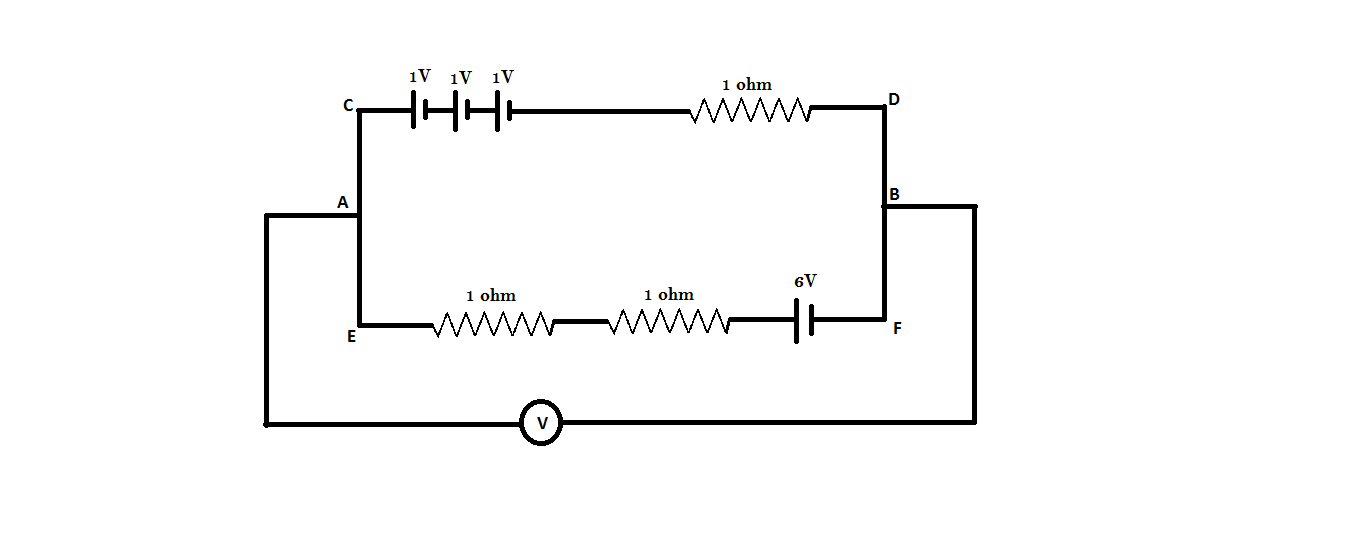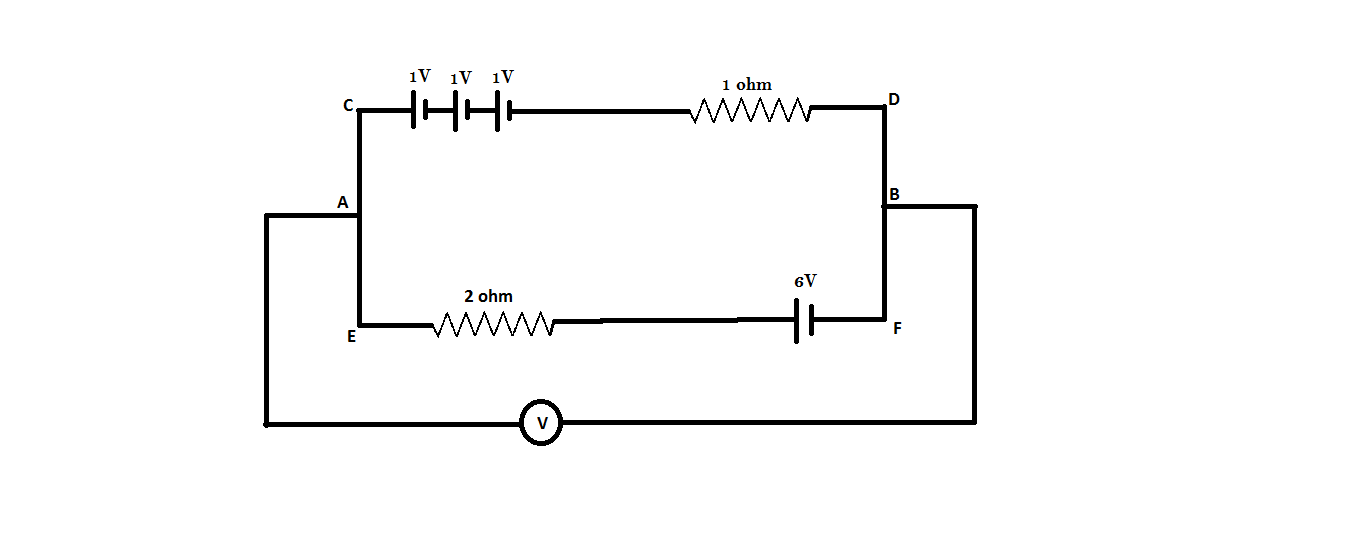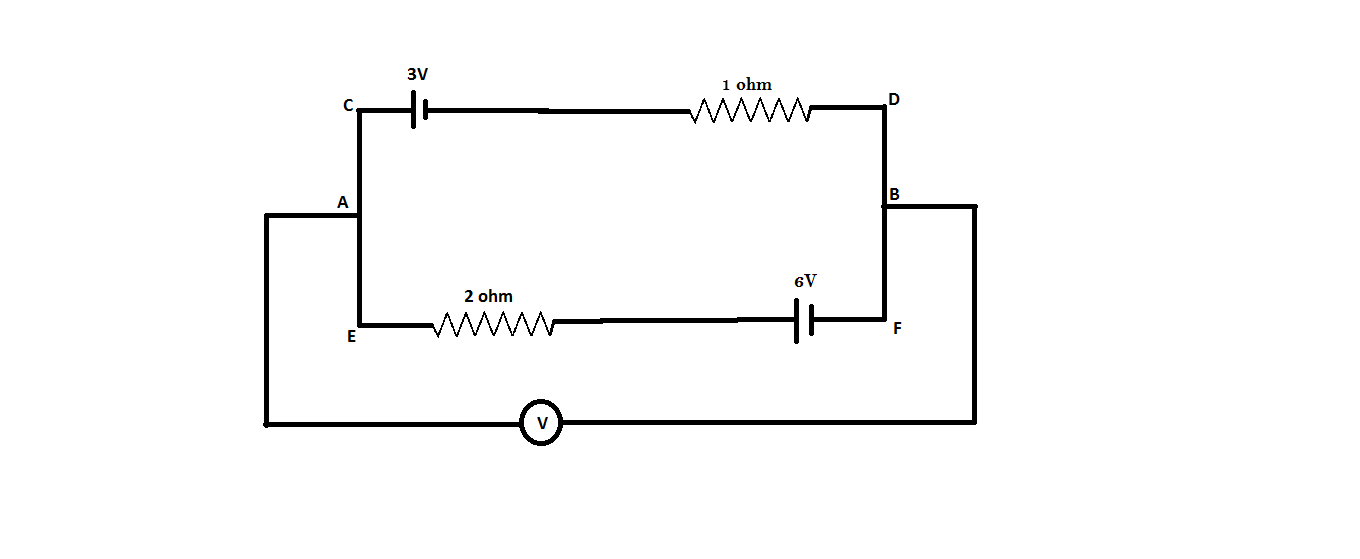
In the following diagram, the reading of an ideal voltmeter in the circuit is:
 A) Zero
A) Zero
B) 2V
C) 4V
D) 6V
Answer
218.4k+ views
Hint: A voltmeter is an instrument used for measuring the electric potential difference between two points in an electric circuit. In the above question, we have to find the potential difference between two points A and B. Use Kirchhoff’s second law of the circuit. Kirchhoff's second law states that the voltage around a loop equals the sum of every voltage drop in the same loop for any closed network and also equals zero. Another thing to keep in mind is that the voltmeter which is connected to the circuit is ideal. An ideal voltmeter is a voltmeter that has infinite resistance, that is, the voltmeter will not allow any amount of current to go through it.
Complete step by step solution:
Step 1: To simplify the diagram we can add two resistors of 1ohm each. Both resistors are in the series combination. To add the resistors in series use the formula $R = {R_1} + {R_2}$ . then our resistance will be 2 ohms and the diagram will look like following
 Step 2: Three batteries are connected in a series combination therefore we can directly add all the three potential differences and can write as a single potential difference which will be 3V. and we can have the following diagram
Step 2: Three batteries are connected in a series combination therefore we can directly add all the three potential differences and can write as a single potential difference which will be 3V. and we can have the following diagram
 Step 3: now apply Kirchhoff’s second law assuming that the current is flowing counterclockwise in the circuit. Let the current flowing in the circuit is $i$ then add all the potential in the circuit and put equal to zero. Since we know the formula, $V = IR$ we can put the potential difference because of each resistor. Therefore,
Step 3: now apply Kirchhoff’s second law assuming that the current is flowing counterclockwise in the circuit. Let the current flowing in the circuit is $i$ then add all the potential in the circuit and put equal to zero. Since we know the formula, $V = IR$ we can put the potential difference because of each resistor. Therefore,
$\therefore - 6 + 1 \times i - 3 + 2i = 0$
$ \Rightarrow - 9 + 3i = 0$
$ \Rightarrow i = \dfrac{9}{3} = 3$
Therefore the current flowing in the circuit is 3A.
Step 4: now we know the amount of current flowing in the circuit and use this for the calculation of the potential difference between point A and point B. therefore
$\therefore {V_A} - 6 + 2 \times i = {V_B}$ , where ${V_A}$ and ${V_B}$ are the potential at point A and B respectively.
Step 5: For the potential difference we need to calculate the value of the ${V_A} - {V_B}$ . Therefore put the value of $i$ and calculate the desired result
$\therefore {V_A} - {V_B} = 6 - 2 \times 3$
$ \Rightarrow {V_A} - {V_B} = 0$
Therefore the reading in the voltmeter will be zero.
Hence option A is correct.
Note: The sign taken for potential in the above solution depends on the direction of the current flowing in the circuit. If we take the flowing current clockwise then the sign of every potential will be changed. But the result, that is, the amount of current will not change.
Complete step by step solution:
Step 1: To simplify the diagram we can add two resistors of 1ohm each. Both resistors are in the series combination. To add the resistors in series use the formula $R = {R_1} + {R_2}$ . then our resistance will be 2 ohms and the diagram will look like following
 Step 2: Three batteries are connected in a series combination therefore we can directly add all the three potential differences and can write as a single potential difference which will be 3V. and we can have the following diagram
Step 2: Three batteries are connected in a series combination therefore we can directly add all the three potential differences and can write as a single potential difference which will be 3V. and we can have the following diagram  Step 3: now apply Kirchhoff’s second law assuming that the current is flowing counterclockwise in the circuit. Let the current flowing in the circuit is $i$ then add all the potential in the circuit and put equal to zero. Since we know the formula, $V = IR$ we can put the potential difference because of each resistor. Therefore,
Step 3: now apply Kirchhoff’s second law assuming that the current is flowing counterclockwise in the circuit. Let the current flowing in the circuit is $i$ then add all the potential in the circuit and put equal to zero. Since we know the formula, $V = IR$ we can put the potential difference because of each resistor. Therefore,$\therefore - 6 + 1 \times i - 3 + 2i = 0$
$ \Rightarrow - 9 + 3i = 0$
$ \Rightarrow i = \dfrac{9}{3} = 3$
Therefore the current flowing in the circuit is 3A.
Step 4: now we know the amount of current flowing in the circuit and use this for the calculation of the potential difference between point A and point B. therefore
$\therefore {V_A} - 6 + 2 \times i = {V_B}$ , where ${V_A}$ and ${V_B}$ are the potential at point A and B respectively.
Step 5: For the potential difference we need to calculate the value of the ${V_A} - {V_B}$ . Therefore put the value of $i$ and calculate the desired result
$\therefore {V_A} - {V_B} = 6 - 2 \times 3$
$ \Rightarrow {V_A} - {V_B} = 0$
Therefore the reading in the voltmeter will be zero.
Hence option A is correct.
Note: The sign taken for potential in the above solution depends on the direction of the current flowing in the circuit. If we take the flowing current clockwise then the sign of every potential will be changed. But the result, that is, the amount of current will not change.
Recently Updated Pages
Young’s Double Slit Experiment Derivation Explained

Chemical Properties of Hydrogen - Important Concepts for JEE Exam Preparation

JEE General Topics in Chemistry Important Concepts and Tips

JEE Atomic Structure and Chemical Bonding important Concepts and Tips

JEE Amino Acids and Peptides Important Concepts and Tips for Exam Preparation

JEE Extractive Metallurgy Important Concepts and Tips for Exam Preparation

Trending doubts
Understanding Atomic Structure for Beginners

Ideal and Non-Ideal Solutions Explained for Class 12 Chemistry

Understanding Electromagnetic Waves and Their Importance

Understanding the Wheatstone Bridge: Principles, Formula, and Applications

JEE Main 2025-26 Mock Test: Ultimate Practice Guide for Aspirants

Understanding Excess Pressure Inside a Liquid Drop

Other Pages
Diffraction of Light - Young’s Single Slit Experiment

Electric field due to uniformly charged sphere class 12 physics JEE_Main

Dual Nature of Radiation and Matter Class 12 Physics Chapter 11 CBSE Notes - 2025-26

Understanding Elastic Collisions in Two Dimensions

MOSFET: Definition, Working Principle, Types & Applications

Explain the construction and working of a GeigerMuller class 12 physics JEE_Main




